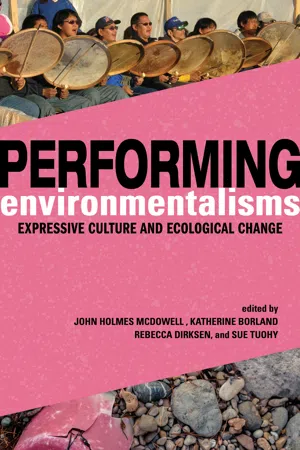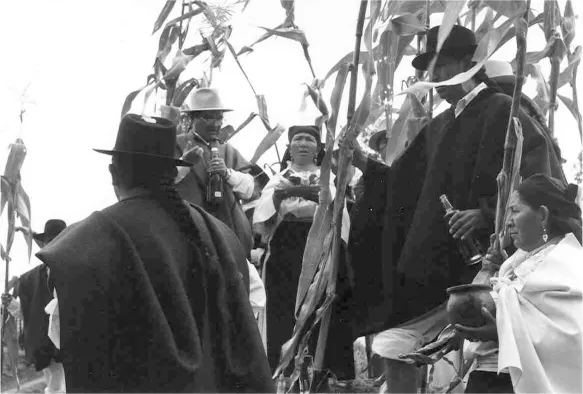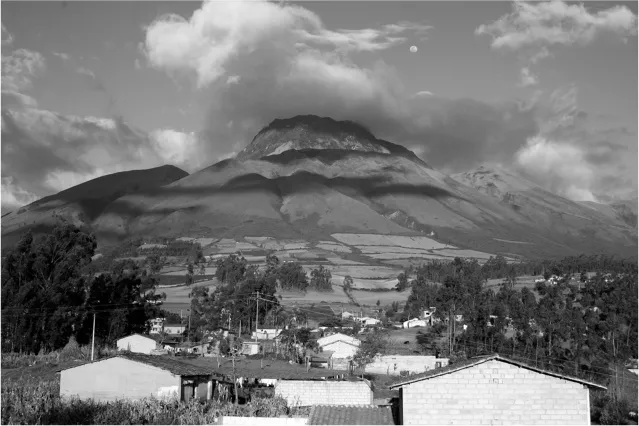![]()
PART I
Perspectives on Diverse
Environmentalisms
![]()
CHAPTER 1
Ecoperformativity
Expressive Culture as Spiritual, Pedagogical,
and Activist Resource
JOHN HOLMES MCDOWELL
At this critical juncture in the Anthropocene, in the thick of the Great Acceleration as humans impact the environment, we might ask if there is any way to stop advanced global capitalism from devouring the earth and all that is on it, underneath it, and above it. Could it be that the voices of local and Indigenous people with a deep connection to locale and land will be the David to vanquish, or at least restrain, this Goliath? Will these voices of people in marginalized, neglected, and often victimized communities, amplified through a supportive chorus of allies, rise to stop the drilling, stifle the pipelines, and restore viability to the planet’s life? There are many disappointments and occasional triumphs in this unequal struggle, but dramas playing out at hundreds of sites indicate that the juggernaut, for all its force, may grind to a halt, ironically, in these typically out-of-the-way places and at the feet of these small but determined adversaries. The present exposition of locally rooted ecological discourse will, I hope, illuminate a social aesthetics at work in arenas of environmental conflict and help explain how seemingly unequal confrontations at this moment of extreme precarity (Tsing 2015) can lead to surprising denouements.
In this chapter I draw upon speech act theory to develop an explanatory model that charts the strategic use of traditional expressive resources—such as story, song, craft, dress, body adornment, music, dance, ceremony, and ritual—in settings of ecological conflict, struggle, and trauma. This model originates in verbal communication but readily encompasses the entire repertoire of human expressivity. The case studies I bring forward to illustrate its workings are centered in the Andes region of South America, but I believe that the model I propose here operates at a sufficient level of abstraction as to possess wide, perhaps universal, applicability. My intention is to formulate a template for assessing the potency of expressive culture in zones of ecological debate, attending to communicative features of these artistic performances and to their social and political impact.
Ecoperformativity highlights the ways that people make use of traditional expressive resources to capture and convey knowledge about the natural environment and to exert influence on processes that threaten their community’s connection to land and locale. In the case of the Indigenous South Americans I reference here, ecoperformativity is founded on ecospiritual participation in the natural world, and this, in turn, is based on ecopedagogical practices that preserve and disseminate this spiritual understanding. I maintain that, for these communities as for many others around the world, a commitment to conserving the natural environment amounts to a claim of ecosovereignty, that is, an assertion of local management of natural resources in accordance with traditional knowledge and practice. Tracking the concept of ecoperformativity, then, opens perspectives on human spirituality, cultural pedagogy, and political activism in relation to human emplacement on planet Earth, and moreover, allows us to trace the dynamic interaction of these frameworks as they compose a signature feature of contemporary geopolitics.
Let’s begin by visiting an instance of ecoperformativity in the northern sector of Ecuador in South America. In 2007, when visiting my Runa compadres in Ilumán,1 one of the seventy or so Indigenous settlements on the periphery of the city of Otavalo, I walked one July afternoon with my family and some of our Otavalo friends to the bottom of the hill near the home of Luis Alberto Yamberla and Maruja Picuasi, where I was living with my wife, Patricia, and our son, Michael, to observe a ceremonial cleansing carried out by a group of yachaks (knowers), the spiritual guardians of the community. We descended to Ilumán Bajo and then crossed the national highway connecting Otavalo with Ibarra and came to the San Juan sacred spring, believed to possess immense spiritual power. There we witnessed the yachaks perform a series of rituals to protect the town of Ilumán, and more generally, the Runa community. The ritual actions included the pukuy, a form of ritual blowing; the breaking of a ceramic pot to spill auspicious elements into the air; and the placing of flowers and cornstalks where the spring waters emerge to honor their source, Taita Imbabura (Lord, or father), the volcano that towers over the area, and to request from spiritual forces in the natural world a good harvest at the beginning of harvest season.
Figure 1.1 Yachaks at San Juan pukyu, 2009. Photograph by Patricia Glushko.
Figure 1.2 Cornstalk offering at San Juan pukyu. Photograph by Patricia Glushko.
The ritual actions of the Ilumán yachaks exhibit a measured control over human expressivity, with language and gesture shaped into recurring patterns, as well as a symbolic discourse evoking the core of Runa cosmology. At the heart of this discourse is a reverence for Taita Imbabura, perceived to be a spiritual presence shaping human destinies. Taita Imbabura animates a sacred landscape, with pukyu—springs—as well as deep ravines and other topographic features serving as spiritually charged points of contact between the human and spiritual realms. San Juan pukyu is one of the most significant of the many nodes of spiritual contact that dot the regional landscape.
Figure 1.3 Taita Imbabura looms over the Indigenous settlements on its flanks. Photograph by author.
This cosmic feature on the landscape became the object of a heated dispute between Runa community members and state authorities when a government plan to widen the highway that passes between Ilumán and the San Juan sacred spring threatened the integrity of San Juan pukyu and its ceremonial setting. The standoff that ensued is emblematic of numerous comparable incidents throughout the Andean nations where local and Indigenous curation of natural resources is pitted against development projects favored by more distant governmental authorities. At San Juan pukyu, authorities ultimately agreed to reroute the highway to avoid the sacred spring and the nearby hill where rituals are performed; the officials also agreed to construct pedestrian bridges that would allow people and their animals to traverse the widened highway without having to cross it.2
In the Ilumán case, as reported by Cultural Survival in July of 2010, “One hundred and eighty Indigenous families from the community mobilized to oppose the road expansion and were met by 350 police in riot gear sent from the provincial capital, Ibarra.” Taita José Rafael Carrascal Cacuango, president of the Asociación de Yachaks de Ilumán (Association of Yachaks of Ilumán), spoke to Michelle Wibbelsman, now a professor at Ohio State University, about the meaning of the sacred spring in these terms: “There is a fuerza (strength, energy) one would say; … the energy of the spring gives people the courage to discuss how to do something to have a voice and to have decision-making power” (Carrascal Cacuango 2010). Previously I had observed my compadre Luis Alberto include San Juan pukyu among the sources of spiritual power in his curing chants; his wife, Maruja, assured me that “the water that emerges at San Juan pukyu is pure” since, as her grandparents had taught her, it comes from deep within Taita Imbabura. Previewing the ritual enactments we witnessed that day in July, she explained that the yachaks go there at the start of the corn harvest to initiate a year’s round of sacred activities. They carry the cornstalk into the water to thank the gods for this year’s crop. They bring a pot with burning coal, fragrant wood, and fragrant plants, she told us, as “una adoración al sol, al viento, a la temporada de la cosecha” (“to revere the sun, the wind, at the season of the harvest”).
These highly patterned and carefully crafted ritual practices ensure a healthy connection to the spiritualized environment, and this connection serves as a source of strength to the Indigenous community in the face of outside encroachment on their physical domains. We can readily place the Otavalo case in the larger context of an Andean spirituality that draws on traditional knowledge and practice to identify and combat incursions that threaten the very resources that nurture these societies. For example, the documentary film Hija de la Laguna (2015), directed by Ernesto Cabellos Damián, portrays the resistance of a highland Peruvian community to a goldmine development project. The film’s protagonist, a woman named Nélida, returns repeatedly to the threatened Conga Lakes to pursue a conversation with Mama Yaku, the spirit of the water. “Why can’t they understand that you are a living being?” she asks of her.3
The scholarly literature is replete with renderings of this telluric spirituality, to use a word that Joseph Bastien (1978) introduces to the discussion. It is a spirituality literally grounded in the earth for the Bolivian Qollahuayas, where he and his wife, Judy, lived in the late 1960s, a spiritual presence that is emplaced in thirteen earth shrines, or huacas, at different levels of Kuntur Qutu, the Mountain of the Condor. Bastien’s work, in turn, references the foundational Huarochirí manuscript, assembled in the mountains just above Lima by Indigenous scribes working essentially as ethnographers of their own community, at the dawn of the seventeenth century. The Huarochirí’s remarkable inventory of mythic narratives features the mountain deity, Pariacaca, and recurrently portrays the earth and its topography as living beings; these mythic formulations are the bedrock of Andean spirituality.4
A long trail of scholarly accounts details expressions of this Andean theme. A recent manifestation is Marisol de la Cadena’s Earth Beings (2015), in which she describes the intimate relationship between the tirakuna, the earth beings rooted in the Peruvian landscape, and the allyus, the human communities these spirits protect and nurture. As with Nélida in Peru and Qollahuayas in Bolivia, the people in de la Cadena’s ethnography are both grounded and empowered by their traditional knowledge and practices. In all these cases, tradition serves as a valuable resource that enables people to organize their thinking and to create expressive routines as they confront challenges to their ways of life in the places they inhabit.
In fact, a continent-wide movement unites scholars and activists in the pursuit of actionable ecological research based on local and Indigenous modes of thought and action that can lead to effective strategies of resilience and resistance (Ulloa 2005, Uzendoski and Calapucha-Tapuy 2012, Escobar 2016, Lederach 2017). In Colombia, for example, environmental justice advocates have joined hands in a resistance effort under the umbrella of Asociación Minga (minga is the Quechua word for communal labor), and comparable alliances can be traced in other countries and regions. I intend my thoughts here on ecoperformativity to serve as a contribution to this larger movement, and indeed, to comparable movements across the globe, on the premise that we who are not indigenous to a region will do well to attend closely to traditional expressive forms at the crux of ecological conflict.
Ecoperformativity: Communicative Power and Efficacy
My purpose, as noted, is to establish the concept of ecoperformativity, founded on speech act theory as articulated initially by John Austin (1962) and developed by his student, John Searle (1969), and many others,5 to account for the ways people construct discourse to make things happen with words. Also as noted, my articulation of ecoperformativity begins with speech, but transitions from utterance to discourse to accommodate the full spectrum of human expressivity. The concept of ecoperformativity helps us see how a connection to the environment is constructed through performance, and how such performance serves as an emotional and intellectual resource as communities resist incursions that threaten the viability of their way of life. By tracing performative genres as they define, formulate, refine, and reinforce local systems of belief and practice—that is, as they constitute these systems—folklorists and ethnomusicologists can elaborate a detailed account of the creative processes and social dynamics that enable artful performances to articulate shared attitudes and beliefs in locally recognized expressive modes—and thereby move people to action.
Ecoperformativity allows us to explain how communication about ecological relationships has the power to shape people’s thinking and move them to act in certain ways. Following the rubric established by John Austin’s How to Do Things with Words (1962), we can identify a set of conditions that must obtain if these episodes are to be felicitous—that is, if they are constructed in such a way that they might achieve their intended impact. In Austin’s formulation of speech act felicity, we attend to the person executing the speech act, the way the speech act is executed, and the circumstances in which the speech act transpires. To get at ecoperformativity, I work this speech act protocol through the tenets of what I have termed commemorative discourse, discourse featuring stylization in the medium of communication in tandem with a focus on core propositions of local worldview (McDowell 1992). As I argued in this earlier work, commemorative discourse “excels in the presentation of transcendental messages, messages that reference a recondite, privileged vision of reality” (ibid., 417). These messages achieve their potency in large part, I argue, due to significant levels of patterning in the medium of expression.
Commemorative discourse can attain remarkable efficacy, well beyond the conveyance of information, an important function of communication, but as Roman Jakobson (1960) alerts us, hardly the only or most significant one. In shifting our attention from the referential to the performative, we embrace the well-documented rhetorical potentialities of artful communication, and beyond that, within contexts of local belief, its capacity, through ritual practice, to transform social status and even (it is sometimes believed) perceived physical reality.6
Working within this conceptual framework, I propose that we track the following communicative elements: adherence to local expectations regarding the formal properties of utterances; referential content that articulates with community understandings of ecospirituality; the performer’s standing as a person entitled to activate ecopedagogy; and performance venues defined as appropriate by community standards. We can formulate these specifications in the framework of Austin’s speech act theory, with reference to two parameters: the felicity conditions that must obtain for a happy execution of ecoperformative speech acts; and the range of potential effects, what Austin addresses as perlocution, which I will refer t...



